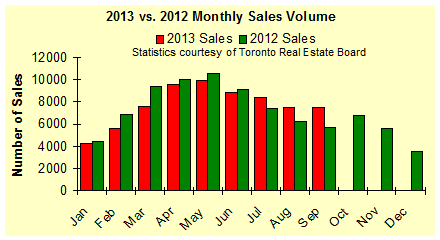Toronto Income Property Newsletter: June 2008
This month I’d like to examine the rental market in Toronto. Last year the City of Toronto’s Shelter, Support & Housing Administration released a report called “Rental Housing Facts & Figures”, which looked at the makeup of income properties. What follows are excerpts from this study which highlights how income properties are still a dominant part of our local real estate market:
As of 2006, there were almost half a million (464,535) rental housing units in the City of Toronto. Tenants make up half of the City’s population and there is believed to be about one million tenants in Toronto. About three-quarters of the rental housing supply (about 350,000 units) is made up of “primary rental housing”, that is, housing units built with the intention of being used as rental. This includes rental housing units built by the private sector (55%) and rental housing units built with financial assistance from the government (20%).
The remaining one-quarter of the rental housing supply is made up of
“secondary rental housing”. Secondary rental housing is housing that was not specifically intended for rental use when it was built. Some examples of secondary rental housing include houses that are rented out, semi-detached houses and duplexes, accessory apartments in houses (also called second suites or basement apartments), and condominium apartments that are rented by their owners. This is the market that I trade in. Secondary rental housing provides a less permanent supply of rental housing as the owners of these rental units may re-occupy or sell the units to a new owner-occupant at any time.
The overall breakdown in Toronto is as follows:
Condo Rental – 5%
Other Rental – 20%
Private Rental – 55%
Assisted Rental – 20%
Primary Rental Market – 75%
Secondary Rental Market- 25%
The supply of primary rental housing (purpose built rentals) has been decreasing in the City of Toronto. The decrease in this supply is due to a variety of factors, including the conversion of high-end rental housing to condominiums, and demolitions. The decrease in primary rental housing is also not being offset by new condominium units being offered for rent. Even though there have been record numbers of new condominium buildings built in Toronto over the last ten years, the number of condominium units offered for rent has decreased. In 2006, there were 1,968 fewer condominium rental units than in 1996. The reason for the decrease is that more and more buyers are occupying their units rather than renting them out.
There has been a dramatic decline in rental housing construction since the 1990s. Private rental construction began declining in 1990 with the cancellation of tax incentives to developers, even though rent controls on new units were removed the same year. In 1995, only 165 private rental units were built. In 2004, the number dropped to just 30 units built. The elimination of rent controls on all new and vacant units under the Tenant Protection Act after 1998 had little effect on private rental construction. A decline in assisted housing construction began in 1993 when federal funding for non-profit and co-operative housing was cancelled, and continued after 1995 when provincial funding was cancelled. The production of all types of new rental housing continues to remain low. Between 2000 and 2004, there were 2,508 rental housing completions, and out of this total, 663 were primary rental units, an average of 68 units per year. Of the 663 total primary rental units, 342 were built by the private sector, and 321 were built with financial assistance from the government. Most of the remaining new rental units (1,845) of the 2,508 rental units built between 2000 and 2004 were units rented in buildings that were registered as condominiums. Condominium rental units are part of the secondary rental market. They do not provide a long term, stable supply of rental housing. In addition, they provide less security to tenants who rent them, compared with tenants renting units in the primary rental market. Tenants renting a condominium unit can be evicted by the owner or purchaser of the unit if the owner or purchaser, or a member of their family, wants to occupy the unit. In 2005, Toronto City Council established a target to create 1,000 new affordable housing units per year. While this target includes all types of housing, it is expected that most would be affordable rental housing.
There continue to be changing conditions in the Toronto rental property market.
For three decades until 2006, average rental vacancy rates for private rental
apartments in the City of Toronto were very low. The vacancy rate started to
increase a little in 2002. In 2002 the vacancy rate was 2.4%, while in 2003 it
was 3.9%, 4.3% in 2004, and in 2005 it was 3.7%. With a vacancy rate of 3.7%,
there were 37 vacant rental units out of every 1,000 units in the City of Toronto
or 9,445 units in total. Today it has dropped down to around 3%.
The higher vacancy rates since 2002 are due to a decline in demand for rental
housing. More households are buying instead of renting, and the number of
households that traditionally rent has declined. More young adults are living with
their parents longer, and good employment combined with favourable interest
rates and construction of condominiums has led to more renters becoming
owners. Immigration to Canada increased significantly during 2000, 2001 and 2002. It dropped sharply in 2003. The decline in immigration levels in 2003 has also contributed to reduced demand for rental housing, however, the number of
immigrants has gone up since 2004. In 2006, Toronto’s vacancy rate fell by more than half a percentage point from 4.3% to 3.7% (representing 1,552 fewer vacant units). According to CMHC, the reduction is a result of recent increases in rental demand due to increasing immigration, incentives offered by landlords, increased costs of home ownership, and low rates of rent increases.
Rental demand can increase quickly as a result of changing market conditions,
immigration levels, and job growth. Therefore, it is important for the city to encourage the development of new primary rental housing to ensure there is a supply of rental housing for the long term. It is also important to protect the existing supply of primary rental housing. There continues to be ample secondary rentals, despite the fact that the returns for absentee investors has diminished over the past two years as result of a hot Sellers’ market.
Before I sign off I’d like to invite all of you to a special investor’s evening being put on by a very close friend of mine, Barak Queija. Barak is a financial planner with Investors’ Group. On June 18th, they are doing a complimentary seminar that will discuss retirement planning, tax planning and wealth building. These are very productive evenings that offer tons of good practical advice. If you are interested in attending please RSVP to 416-491-7400 ext 643.
Next month I will look at the perceived slow-down in the Toronto market and analyze if income properties are still going through the roof in multiple offers. Don’t forget that Euro 2008 starts next week and remember to cheer on our local team, who are having a much better go of it so far this year.
Take care everyone.
P.A.



